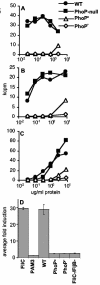CD4+ T cells and toll-like receptors recognize Salmonella antigens expressed in bacterial surface organelles
- PMID: 15731032
- PMCID: PMC1064935
- DOI: 10.1128/IAI.73.3.1350-1356.2005
CD4+ T cells and toll-like receptors recognize Salmonella antigens expressed in bacterial surface organelles
Abstract
A better understanding of immunity to infection is revealed from the characteristics of microbial ligands recognized by host immune responses. Murine infection with the intracellular bacterium Salmonella generates CD4+ T cells that specifically recognize Salmonella proteins expressed in bacterial surface organelles such as flagella and membrane vesicles. These natural Salmonella antigens are also ligands for Toll-like receptors (TLRs) or avidly associated with TLR ligands such as lipopolysaccharide (LPS). PhoP/PhoQ, a regulon controlling Salmonella virulence and remodeling of LPS to resist innate immunity, coordinately represses production of surface-exposed antigens recognized by CD4+ T cells and TLRs. These data suggest that genetically coordinated surface modifications may provide a growth advantage for Salmonella in host tissues by limiting both innate and adaptive immune recognition.
Figures






References
-
- Adams, P., R. Fowler, N. Kinsella, G. Howell, M. Farris, P. Coote, and C. D. O'Connor. 2001. Proteomic detection of PhoPQ- and acid-mediated repression of Salmonella motility. Proteomics 1:597-607. - PubMed
-
- Aldridge, P., and K. T. Hughes. 2002. Regulation of flagellar assembly. Curr. Opin. Microbiol. 5:160-165. - PubMed
-
- Aliprantis, A. O., R. B. Yang, M. R. Mark, S. Suggett, B. Devaux, J. D. Radolf, G. R. Klimpel, P. Godowski, and A. Zychlinsky. 1999. Cell activation and apoptosis by bacterial lipoproteins through toll-like receptor-2. Science 285:736-739. - PubMed
-
- Allan, N. D., C. Kooi, P. A. Sokol, and T. J. Beveridge. 2003. Putative virulence factors are released in association with membrane vesicles from Burkholderia cepacia. Can. J. Microbiol. 49:613-624. - PubMed
Publication types
MeSH terms
Substances
Grants and funding
LinkOut - more resources
Full Text Sources
Other Literature Sources
Research Materials

